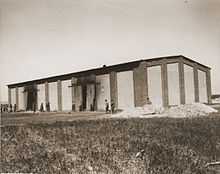102nd Infantry Division (United States)
| 102nd Infantry Division | |
|---|---|
|
102nd Infantry Division shoulder sleeve insignia | |
| Active | 1942–1946 |
| Country | United States |
| Branch | United States Army |
| Role | Infantry |
| Size | Division |
| Nickname | Ozark (Special Designation)[1] |
| Motto | Distinction, Valor, Marksmanship |
| Engagements |
World War II *Central Europe |
| Insignia | |
| Distinctive Unit Insignia |
 |
| US infantry divisions (1939–present) | |
|---|---|
| Previous | Next |
| 101st Airborne Division | 103rd Infantry Division |
The 102d Infantry Division ("Ozark"[1]) was a unit of the United States Army in World War II.
World War II
- Activated: 15 September 1942 at Camp Maxey, Texas
- Overseas: 12 September 1944
- Campaigns: Rhineland, Central Europe
- Days of combat: 173
- Distinguished Unit Citations: 4
- Awards: DSC-8; DSM-1 ; SS-686; LM-15; SM-39 ; BSM-5,498 ; AM-91.
- Commanders: Major General John B. Anderson (September 1942-December 1943), Major General Frank A. Keating (8 January 1944 – February 1946), Brigadier General Charles M. Busbee (February 1946 to inactivation).
- Assistant Division Commanders (partial list): Lloyd D. Brown (May 1942-February 1943), Alonzo Patrick Fox (April 1943-May 1945)
- Returned to U.S.: 11 March 1946.
- Inactivated: 23 March 1946.
Patch was used in 1986 for the Military Police unit stationed at Richards Gebaur AFB near Belton Missouri.
Combat chronicle
The 102d Infantry Division arrived at Cherbourg, France, 23 September 1944, and, after a short period of training near Valognes, moved to the German-Netherlands border. On 26 October, elements attached to other divisions entered combat and on 3 November the division assumed responsibility for the sector from the Wurm to Waurichen. A realignment of sectors and the return of elements placed the 102d in full control of its units for the first time, 24 November 1944, as it prepared for an attack to the Roer. The attack jumped off, 29 November, and carried the division to the river through Welz, Flossdorf, and Linnich.
After a period of aggressive patrolling along the Roer, 4–19 December, the division took over the XIII Corps sector from the Wurm River, north of the village of Wurm, to Barmen on the south, and trained for river crossing. On 23 February 1945, the 102d attacked across the Roer, advanced toward Lövenich and Erkelenz, bypassed Mönchengladbach, took Krefeld, 3 March, and reached the Rhine. During March the division was on the defensive along the Rhine, its sector extending from Homburg south to Düsseldorf. Crossing the river on 9 April on pontoon bridge, the division attacked in the Wesergebirge, meeting stiff opposition. After 3 days and nights of terrific enemy resistance Wilsede and Hessisch-Oldendorf fell, 12 April 1945, and the 102d pushed on to the Elbe, meeting little resistance. Breitenfeld fell, 15 April, and the division outposted the Elbe River, 48 miles from Berlin, its advance halted on orders. Storkau experienced fighting on the 16th,EHRA on the 21st along with Fallersleben. On 3 May 1945 the 102nd shook hands with the Russian 156th Division just outside Berlin.

On 15 April the division discovered a war crime in Gardelegen. About 1,200 prisoners were herded into the empty barn measuring approximately a hundred by fifty feet on the outskirts of the town. The barn was then burned down, killing those inside. About 1,016 people were killed. The division commander ordered that the civilian population be forced to view the site and to disinter and rebury the victims in a new cemetery. After digging the graves and burying the bodies, they erected a cross or a Star of David over each grave and enclosed the site with a white fence.[2]
It patrolled and maintained defensive positions until the end of hostilities in Europe, then moved to Gotha for occupational duty.
Assignments in the European Theater of Operations
- 28 August 1944: Ninth Army, 12th Army Group.
- 5 September 1944: III Corps.
- 10 October 1944: XVI Corps.
- 3 November 1944: XIX Corps.
- 7 November 1944: XIII Corps.
- 20 December 1944: XIII Corps, Ninth Army (attached to the British 21st Army Group), 12th Army Group.
- 1 April 1945: XIII Corps (for administration), Ninth Army, but attached for operations to the Fifteenth Army.
- 4 April 1945: XIII Corps, Ninth Army, 12th Army Group.
General
- Nickname: Ozark Division.
- Slogan: Distinction, valor, marksmanship.
- Shoulder patch: A golden "O", "Z" and an arc on a circular blue background.
References
![]() This article incorporates public domain material from the United States Army Center of Military History document "The Army Almanac: A Book of Facts Concerning the Army of the United States U.S. Government Printing Office, 1950".
This article incorporates public domain material from the United States Army Center of Military History document "The Army Almanac: A Book of Facts Concerning the Army of the United States U.S. Government Printing Office, 1950".
- ↑ 1.0 1.1 "Special Unit Designations". United States Army Center of Military History. 21 April 2010. Archived from the original on 9 July 2010. Retrieved 9 July 2010.
- ↑ U.S. Holocaust Memorial Museum. "The Year of 1945 Liberation," Washington, D.C., 1945, pp. 69-70
